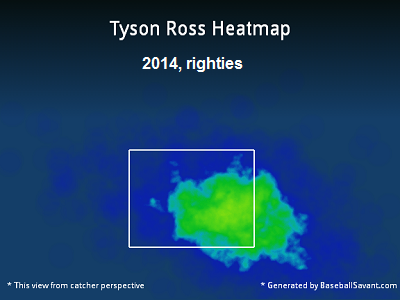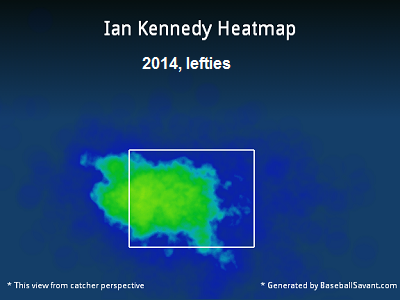Yasmani Grandal and Padres Pitchers
Not to beat a dead horse, or any kind of horse, but the Matt Kemp trade has been lopsided. There’s still an awful long way to go, but for now the Matt Kemp trade is more like the Yasmani Grandal trade, and Grandal and the Dodgers couldn’t be happier. The other day on Twitter I was tipped off to an article about Grandal written by Matt Calkins. The headline: “Padres blew it with Yasmani Grandal.” It talks about Grandal’s limited playing time, and the lack of trust some Padres pitchers had in him. One paragraph stood out to me as particularly interesting:
Despite the general San Diego approach being to throw down and away, Grandal thought the power pitchers should be throwing inside in the early part of the count before using the outer half of the plate to record the out. But the veteran hurlers weren’t catching his drift, and as a result, he wasn’t catching their pitches.
Pitchers identified were Andrew Cashner, Tyson Ross, and Ian Kennedy. Last season, Grandal didn’t catch Cashner. Ross eventually stopped throwing to him, and Kennedy did too. They preferred working with Rene Rivera. This year, the Padres pitching staff has struggled. From the bottom of the same article:
San Diego’s pitching, however, has disappointed, and Grandal can’t help but wonder if that would be the case had his advice been heeded.
On the one hand, this doesn’t really matter. Grandal isn’t in San Diego anymore, so everyone just ought to move on. But on the other hand, this can be an interesting thing to investigate. So let’s talk about what Grandal talked about.
The Padres do like working low and away. Take a look at some heat maps from Baseball Savant. Tyson Ross, a year ago, against righties:

Ian Kennedy, a year ago, against lefties:

Okay, so that’s more “away” than “down and away,” but the bigger point is you don’t see a lot of activity inside. Grandal says he wanted more inside pitches. The pitchers didn’t want to throw them. Last year, against right-handed hitters, Padres pitchers threw the lowest rate of inside pitches in baseball. Against left-handed hitters, they were in the middle of the pack. This year, for the sake of comparison, against righties, the Padres’ inside-pitch rate ranks 28th. Against lefties, it’s eighth. If anything, this year the Padres are throwing in a little bit more.
Now, let’s look at some individual examples. As noted, last year, Grandal didn’t catch Cashner. He did catch Ross and Kennedy, earlier on. Cashner threw about an average rate of inside pitches against righties. His rate was below-average, against lefties. Kennedy had a very low rate of inside pitches against righties, and a nearly-average rate of inside pitches against lefties. Ross had an even lower rate of inside pitches against righties, but a very high rate of inside pitches against lefties, on account of his slider.
Looking at Kennedy, he threw the same rate of inside pitches against righties, whether he was or wasn’t pitching to Grandal. Against lefties, he threw fewer inside pitches with Grandal than he did with Rivera.
It’s a similar story with Ross. Not much of a difference in inside-pitch rate against righties, when broken down by catcher. Against lefties, though, you see more inside pitches with Rivera than with Grandal. Not by a lot, but by a few percentage points.
But this could just be Grandal being overruled. He didn’t get so many inside pitches, but he didn’t get them presumably because the pitchers didn’t want to throw them, and the pitchers decide what they want to throw. Grandal could make suggestions, but he was never the guy actually on the mound.
What if the Padres had gone with Grandal’s philosophy? What if Cashner, Ross, and Kennedy mixed in more inside pitches? Now, it’s absolutely impossible to know what would’ve happened had things been done differently. There’s just no way to run those experiments. But this is a really important point: Cashner, Ross, and Kennedy combined to be pretty damn good, doing what they did. Even mostly not throwing to Grandal, even not doing what he would’ve preferred, here are the statistics:
Cashner/Ross/Kennedy, 2014
- 89 ERA-
- 88 FIP-
- 90 xFIP-
They were a good deal better than average. When Kennedy was excellent in 2011, he threw inside more often against righties, but he was still good last season. So, a year ago, nothing was really wrong. It’s only this year the numbers are worse:
Cashner/Ross/Kennedy, 2015
- 114 ERA-
- 107 FIP-
- 96 xFIP-
Home runs have skyrocketed. The strikeouts are still there, but now there are more walks, fewer strikes. The simplest explanation to me, beyond some bad dinger luck: the receivers are worse. Grandal did and still does rate as an excellent pitch-framer. The same goes for Rene Rivera, who has long been hailed as a defensive specialist. The Padres don’t have those framers anymore, to buy them extra strikes. The Padres’ receivers now aren’t bad, but they’re no longer elite, and it makes sense the pitching staff would suffer as a consequence. So it would be less about philosophy, and more about taking a step back at the margins.
We might as well keep going. It stands to reason that Grandal would bring the same ideas to Los Angeles. And he says he’s a lot happier, suggesting people are paying him more attention. But a year ago, against righties, the Dodgers’ inside-pitch rate ranked in the upper half. This year, they’re 27th. There’s been no increase in inside pitches thrown against lefties. Here’s Zack Greinke, singing Grandal’s praises in early April:
“He’s been unbelievable back there,” Greinke said. “His catching is better than advertised, and working with me individually, he’s been as good as you could expect. I don’t think, from what I’ve seen so far, you could ever have expected anything more.
“He’s done everything. His hands are great. He’s blocked everything I’ve thrown. People stole on him last year, but he’s had some really good throws in games I’ve thrown in spring training. And then his game calling’s been good.
“I couldn’t draw up a better catcher at the moment.”
Greinke against lefties, in each of the last two years:
This year, Greinke has one of baseball’s lowest inside-pitch rates against lefties. And, Greinke against righties:
This year, Greinke has one of baseball’s lowest inside-pitch rates against righties. He’s working away more than he did in 2014. He’s thrown away more often with Grandal than he has with A.J. Ellis. Something similar can be observed with Carlos Frias. Compared to last year, Frias is spending less time this year in the inner parts of the zone and beyond. He’s been caught mostly by Grandal. What these points suggest is that, if Grandal has the same ideas as he did a year ago, he still isn’t getting those pitches. But he doesn’t seem to mind, and the Dodgers are having success. Greinke hasn’t allowed a run in a month.
Per usual, it’s complicated. Grandal had his disagreements with some of the Padres pitchers. Those pitchers preferred to throw to somebody else, and while Grandal could take that as a slight, it’s not like Rivera is chopped liver — in fact, last season, he was quite valuable, both behind and beside the plate. Rivera was good, and the pitchers were good, and while that limited Grandal’s time, it wasn’t a terribly obvious mistake. And while those pitchers have performed worse in 2015, they’re missing the help they got a year ago, so there’s more to it than just not pitching inside. It’s not like the Dodgers are suddenly pitching inside a ton, with Grandal on the roster. Greinke is doing the opposite. Frias is doing the opposite.
It could be that Grandal just didn’t mesh with the pitchers in San Diego. And it’s easier to rid yourself of one catcher than multiple starters. Maybe the personalities didn’t get along. And as the original article noted, Grandal had the PED suspension, and that was a clubhouse problem. Maybe there was no coming back from that. Alternatively, maybe things would’ve worked out in 2015, if the Padres kept Grandal, while dealing Rivera. That much is hard to say. But we know this — in Los Angeles, Grandal was given a fresh start. And because of his experiences in San Diego, he learned a few things about developing better relationships with the pitchers. When you’re a catcher, those relationships in large part determine how often you’re going to play. Grandal’s situation in San Diego did get messed up, somewhat. But there was a lot going on. Moving to the Dodgers has worked out perfectly. There just isn’t any of the same conflict.
Jeff made Lookout Landing a thing, but he does not still write there about the Mariners. He does write here, sometimes about the Mariners, but usually not.
The best part of the All-Star Game was when Rizzo, Gonzalez, and Grandal came up to bat back-to-back-to-back. Wonderful to see that as a Padres fan.